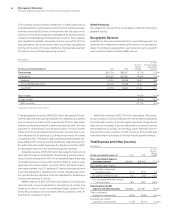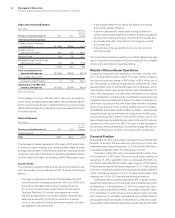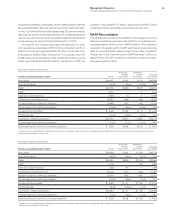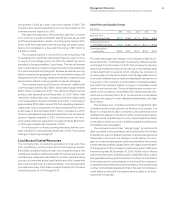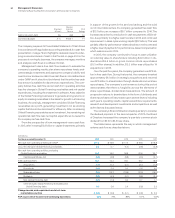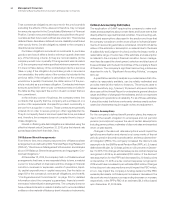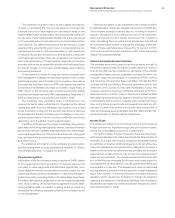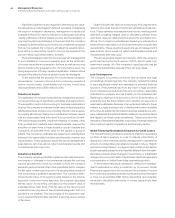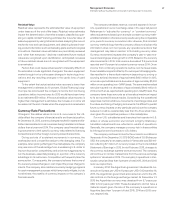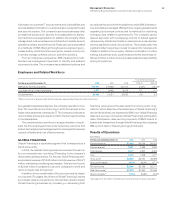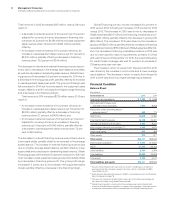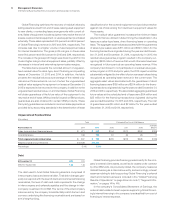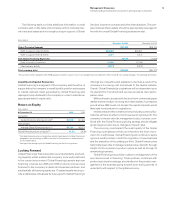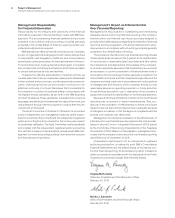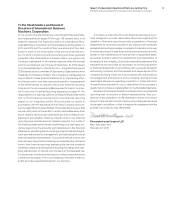IBM 2015 Annual Report Download - page 67
Download and view the complete annual report
Please find page 67 of the 2015 IBM annual report below. You can navigate through the pages in the report by either clicking on the pages listed below, or by using the keyword search tool below to find specific information within the annual report.65
Management Discussion
International Business Machines Corporation and Subsidiary Companies
The expected long-term return on plan assets assumption
is used in calculating the net periodic pension (income)/cost.
Expected returns on plan assets are calculated based on the
market-related value of plan assets, which recognizes changes in
the fair value of plan assets systematically over a five-year period
in the expected return on plan assets line in net periodic pension
(income)/cost. The differences between the actual return on plan
assets and the expected long-term return on plan assets are rec-
ognized over five years in the expected return on plan assets line
in net periodic pension (income)/cost and also as a component
of actuarial (gains)/losses, which are recognized over the service
lives or life expectancy of the participants, depending on the plan,
provided such amounts exceed thresholds which are based upon
the benefit obligation or the value of plan assets, as provided by
accounting standards.
To the extent the outlook for long-term returns changes such
that management changes its expected long-term return on plan
assets assumption, each 50 basis point increase or decrease in
the expected long-term return on PPP plan assets assumption
would have an estimated decrease or increase, respectively, of
$263million on the following year’s pre-tax net periodic pension
(income)/cost (based upon the PPP’s plan assets at December31,
2015 and assuming no contributions are made in 2016).
The company may voluntarily make contributions or be
required, by law, to make contributions to its pension plans. Actual
results that differ from the estimates may result in more or less
future company funding into the pension plans than is planned
by management. Impacts of these types of changes on the com-
pany’s pension plans in other countries worldwide would vary
depending upon the status of each respective plan.
In addition to the above, the company evaluates other pension
assumptions involving demographic factors, such as retirement
age and mortality, and updates these assumptions to reflect expe-
rience and expectations for the future. Actual results in any given
year can differ from actuarial assumptions because of economic
and other factors.
For additional information on the company’s pension plans
and the development of these assumptions, see NoteS, “Retire-
ment-Related Benefits,” on pages 133 and 134.
Revenue Recognition
Application of the various accounting principles in GAAP related
to the measurement and recognition of revenue requires the
company to make judgments and estimates. Specifically, com-
plex arrangements with nonstandard terms and conditions may
require significant contract interpretation to determine the appro-
priate accounting, including whether the deliverables specified in
a multiple-deliverable arrangement should be treated as separate
units of accounting. Other significant judgments include deter-
mining whether IBM or a reseller is acting as the principal in a
transaction and whether separate contracts are considered part
of one arrangement.
Revenue recognition is also impacted by the company’s ability
to estimate sales incentives, expected returns and collectibility.
The company considers various factors, including a review of
specific transactions, the creditworthiness of the customers,
historical experience and market and economic conditions
when calculating these provisions and allowances. Evaluations
are conducted each quarter to assess the adequacy of the esti-
mates. If these estimates were changed by 10percent in 2015,
net income would have been impacted by $77million (excluding
Global Financing receivables).
Costs to Complete Service Contracts
The company enters into numerous service contracts through its
Global Services business. During the contractual period, revenue,
cost and profits may be impacted by estimates of the ultimate
profitability of each contract, especially contracts for which the
company uses thepercentage-of-completion (POC) method
of accounting. If at any time these estimates indicate the POC
contract will be unprofitable, the entire estimated loss for the
remainder of the contract is recorded immediately in cost. The
company performs ongoing profitability analyses of its POC-
based services contracts in order to determine whether the latest
estimates require updating. Key factors reviewed by the company
to estimate the future costs to complete each contract are future
labor costs, future product costs and expected productivity effi-
ciencies. Contract loss provisions recorded as a component of
other accrued expenses and liabilities were $12million and $13mil-
lion at December31, 2015 and 2014, respectively.
Income Taxes
The company is subject to income taxes in the U.S. and numerous
foreign jurisdictions. Significant judgments are required in deter-
mining the consolidated provision for income taxes.
During the ordinary course of business, there are many trans-
actions and calculations for which the ultimate tax determination is
uncertain. As a result, the company recognizes tax liabilities based
on estimates of whether additional taxes and interest will be due.
These tax liabilities are recognized when, despite the company’s
belief that its tax return positions are supportable, the company
believes that certain positions may not be fully sustained upon
review by tax authorities. The company believes that its accruals
for tax liabilities are adequate for all open audit years based on
its assessment of many factors, including past experience and
interpretations of tax law. This assessment relies on estimates
and assumptions, and may involve a series of complex judgments
about future events. To the extent that new information becomes
available which causes the company to change its judgment
regarding the adequacy of existing tax liabilities, such changes to
tax liabilities will impact income tax expense in the period in which
such determination is made.



